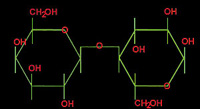Escherichia coli (LacZ)
Beta Galactosidase
As you proceed through this tutorial buttons must be activated in sequence to work
correctly. If you want to redo the tutorial RELOAD the program.
I. Introduction
Beta galactosidase the molecule rotating on the left is an enzyme that initiates the
breakdown of the sugar lactose. Lactose is a type of sugar found in milk. It is composed of two
rings. The rings contain 5 carbon atoms, one at each corner (not shown) and an oxygen
atom (O).
Attached to the carbon atoms are a hydrogen atom (not shown --) and an OH group or
another carbon (C).

The rings are bound together by an oxygen bridge. This bridge can be broken when the
enzyme beta galactosidase binds to lactose and a water molecule reacts with the oxygen atom in the bridge.
Reactions in which water molecules are added are known as hydrolysis
reactions.
The beta galactosidase you will be using in lab this week was isolated from the bacteria
Escherichia coli. This bacteria produces beta galactosidase when lactose is present in its growth
media.
II. General Structure of Beta Galactosidase Complexed with Lactose
The structure of the molecule on the left was determined using X-ray diffraction techniques.
It is a homotetramer meaning that it is composed of four identical chains of amino acids. Click the button
to more clearly see each chain. Each chain has a site where it can interact with a lactose molecule. Click the button
to see how the lactose molecule
associates with the enzyme. If you right click on the molecule with your mouse you will bring up a menu that
will allow you to stop the rotation of the molecule. Then by left clicking and holding the button down you
can rotate the molecule to more clearly see the lactose as it associates with the enzyme. Try to orient the
enzyme lactose complex so that you can see the double ring structure of the lactose. Zoom in on the lactose
molecule. In this view you are only seeing the backbone of the homotetramer and the structure
of the lactose molecule. You may rezoom if you like.
III. The Hydrolysis Reaction
Association of lactose with beta galactosidase facilitates the reaction between water
and lactose. This breaks the oxygen bridge and results in the production of two simple sugars.
IV. The Assay
In your experiments you will be using ONPG in place of lactose. Like
lactose ONPG is a molecule composed of two rings held together by an oxygen bridge. Beta galactosidase also forms
a complex with ONPG molecules and is able to hydrolyze them. Load the .
Be patient as it will take awhile for the molecule to load. ONPG occupies a position similar to that
of lactose. To see the ONPG molecules click on the button . In this view molecules associated with the protein chains are shown in a space filled
form. ONPG appears as a large cluster of molecules embeded in the four protein chains. You can also
see the sodium and magnesium atoms associated with the protein backbone. Activate
this button to more clearly see the ONPG . Right click on the molecule and stop the rotation. Now hold the left button
down and rotate the molecule to see the location of the ONPG molecules. They are composed of double rings
just like lactose. How many ONPG molecules are complexed with each chain?
Beta galactosidase facilitates the hydrolysis of ONPG. When ONPG is hydrolyzed
a yellow product ONP is produced.
The intensity of color produced can be used to measure the rate at which beta Galactosidase can hydrolyze ONPG
(or lactose).